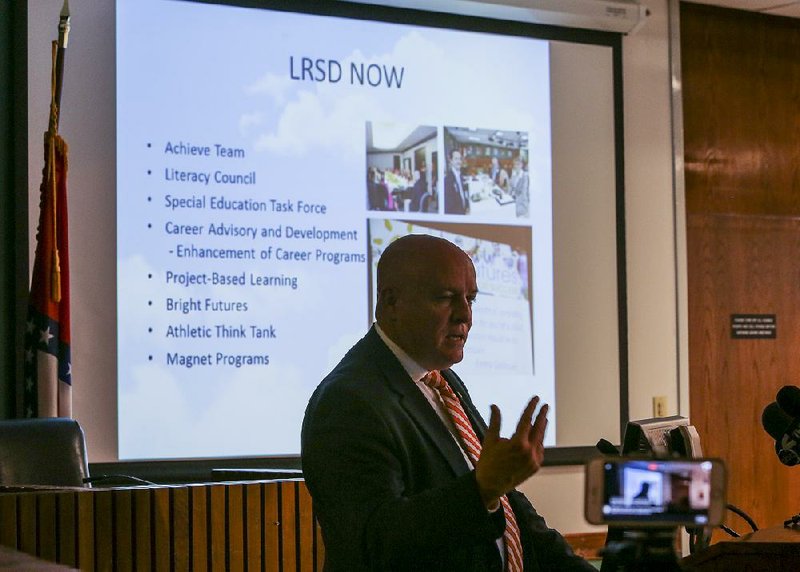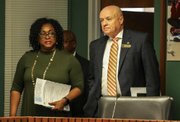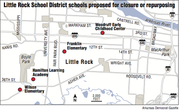Little Rock School District Superintendent Mike Poore on Tuesday announced a newly revised list of budget cut proposals for 2017-18 that will close or repurpose four campuses but, in a change, will keep Carver Magnet Elementary on the city’s east side in operation.
Franklin Elementary, Woodruff Early Childhood Education Center and W.D. “Bill” Hamilton Learning Academy buildings will be closed if Poore’s proposals to Arkansas Education Commissioner Johnny Key are approved.
Additionally, Wilson Elementary School would be closed as a kindergarten-through-f ifth-grade school but would become home to the Hamilton Learning Academy alternative-education program for secondary students who have not been successful in their regular schools.
A community meeting on the budget-cutting and school closure plan is set for today from 5:30 p.m. to 7:30 p.m. in Franklin Elementary at 1701 S. Harrison St., near the University of Arkansas at Little Rock. A second community meeting will be from 5:30 p.m. to 7:30 p.m. Thursday in Wilson Elementary at 4015 Stannus Road, west of University Avenue and off Colonel Glenn Road.
Anyone who attends and wishes to speak or ask questions will have up to three minutes to do so. Feedback from the meetings will be shared with the commissioner.
The school closures and re-purposing would save the district about $3.8 million — about one-third of the $11.6 million to be excised from the district’s budget for the coming school year. Other proposed cuts include $3 million in middle and high school staffing, $2.5 million in school bus transportation, $1 million in central office administrative positions, $875,000 in energy conservation savings, elimination of secondary teacher stipends for lunch, hall and bus supervision duties, and $100,000 in legal expenses.
The budget cutting plans are largely necessary to complete efforts taken over several years to adjust for the end of $37.3 million a year in state desegregation aid after the 2017-18 school year. The budget cuts in 2017-18 would be in addition to $9.3 million budget cuts this year, $18.2 million in 2015-16 and $2.7 million in 2014-15, according to district data.
The terms of a January 2014 settlement agreement in a 3-decades-old Pulaski County school desegregation lawsuit set the ending date for the special aid to the Little Rock, North Little Rock and Pulaski County Special school districts.
“The recommendations that I’m presenting in terms of getting our budget balanced — really there are not many new ideas at all associated with that,” Poore said. “It’s about trying to be very transparent in terms of what we are recommending, and coming up with solutions to get us to a place where we least impact our students. Our belief is that … we are going to end up being a better district because of the actions that are getting ready to take place over the next several months.”
Poore’s budget-cutting recommendations will go to Key in the last week of January and could be acted on by Key within a week or so after that.
Key acts in place of a school board for the 24,386-student district that has been operating under state control — with a state appointed leader and without a locally elected school board — since January 2015. The state took over Arkansas’ largest school district after six of the district’s then 48 schools were labeled as academically distressed because fewer than half of their students scored at proficient levels on state exams over a three-year period. That number of academically distressed schools has since dropped to five.
According to the budget plan presented by Poore at Tuesday’s live-streamed, hourlong news conference, Franklin Elementary pupils would be reassigned to Stephens Elementary next year.
Wilson Elementary pupils would be divided among Bale, Brady, Romine and Western Hills elementaries, with the preponderance of the children going to Romine and Western Hills. The early-childhood education center program for 3- and 4-year-olds now housed at the Woodruff campus, at 3010 W. Seventh St. near Lamar Porter baseball field, will be relocated to Martin Luther King Jr. Elementary, which is near Arkansas Children’s Hospital, and to Carver Magnet Elementary.
Staff members at the affected schools would be assigned to other jobs in the district, said Poore, who also said it is his hope to retain all of the church, business and hospital partners currently affiliated with the affected schools.
Poore said there are no immediate plans for alternative uses for the Franklin and Woodruff campuses to keep those buildings from sitting vacant in their neighborhoods. But, he said, if the budget plans are approved, district leaders will request proposals from area business organizations for use of the buildings. Any resulting proposals will be submitted to community groups to be vetted and that could happen as soon as in March, he said.
Asked about the possibility of the campuses being acquired by competing open-enrollment charter schools, Poore said he believes there are already enough publicly supported elementary school seats in the district. He also said none of the organizations making inquiries about the campuses, to date, have been charter schools.
As for the Hamilton campus, Poore said district leaders will use the next school year to explore the possibility of establishing a kindergarten-through-eighth-grade campus on that campus and the adjoining Bale Elementary School.
At the request of the family of the late Bill Hamilton, the district is likely to preserve the Hamilton name by transferring it to the Wilson school, Poore said. Bill Hamilton was a Little Rock School Board member in the 1980s and 1990s, and his family members continue to live in the city.
The revised list of budget-cut items released Tuesday is the latest development in a process that began in earnest Nov. 2.
In November, Poore proposed closing five schools, including Carver at 2100 E. Sixth St., which as a magnet campus is open to pupils across the district and features a specialty program in mathematics and science.
The school — which as a magnet school previously served pupils from North Little Rock and Pulaski County Special districts as well as the Little Rock district — is down to 290 pre-kindergartenthrough-fifth-grade students this year as compared with 474 pupils three years ago.
Parents and Carver school staff members attended each community forum conducted by Poore on the budget cuts in each of the seven School Board election zones. The Carver supporters — identifiable by their red Carver T-shirts — advocated for keeping their school open.
Poore on Tuesday called the community meetings important and said the feedback collected from them shaped his final set of recommendations.
Kimberly Martin, president of the Carver Magnet Elementary PTA, said Tuesday that she was excited about the changed recommendation to continue to operate Carver as a science and mathematics magnet school.
“We are going to find new ways to promote our school because it is a little isolated,” Martin said, adding that new businesses are moving into the area. “We have excellent programs and great teachers, and people who come to our school will be very pleased with it.”
Poore said Carver has been able to keep students for their elementary school years once they enroll at the school. He also said there is a revitalization in the eastern part of the city that warrants retaining the school and that central Arkansas residents like to have school choices. The district will take steps to enhance its magnet or choice schools, he said.
Poore said extra time will be provided to parents to enroll their children at Carver for the coming school year if the budget plan is approved.
Not everyone Tuesday welcomed the revised budget plans, particularly the plans affecting the neighborhood campuses.
Anika Whitfield, a leader in the active Save Our Schools grass-roots organization, issued a statement on the organization’s behalf Tuesday “to firmly denounce” the proposed closing of schools, calling them the bedrock of the neighborhoods and providers of essential services.
“Closing them will hurt students by disrupting their education, forcing them to move, and contributing to overcrowded classrooms where teachers are continually forced to do more with less,” the statement said.
The closures and budget cuts will not be equitably shared across the district, the statement continued, but will “egregiously and disproportionately place the burden on the African-American neighborhoods south of Interstate 630.”
Poore has said repeatedly that the district has more than 2,300 vacant elementary school seats — more than 4,000 seats, if those in portable classroom buildings are also counted.
The Save Our Schools coalition, however, discounted that, saying business leaders are targeting the areas for redevelopment on the basis of growth projections.
The statement further said there exists no democratic process for making the budget decisions and that outlets for community have been “a farce” with no real opportunity for people in the affected neighborhoods to have a say. They call for a return of the district’s management to a locally-elected school board.
The coalition also said that neither Poore nor Key has “lifted a voice to advocate for the most vulnerable students in this district,” and appear to be putting interests in charter and private schools — advocated by the powerful in the community — above the interest of students enrolled in the district they are in charge of managing.
Poore on Tuesday highlighted some of his work since becoming superintendent July 1 that has included developing the “Achieve Team” approach to providing resources to academically distressed schools, developing high school courses in five career fields for next school year, and establishing the Bright Futures program that matches community resources to individual student needs via social media. The district has formed task forces on literacy and special education, and in the coming weeks will conduct an “athletic think tank” to build up those district operations.
Also Tuesday, Poore announced the appointment of Associate Superintendent Sadie Mitchell to oversee the implementation of the budget cuts, including staff and student reassignments, and movement of equipment and supplies.
He said the district is putting into effect a hiring freeze for the remainder of this school year.
The Little Rock School District has a 2016-17 budget of $344.6 million in revenue and $355.9 million in projected expenses, which includes $34 million for a new middle school project and other capital improvement expenses. District leaders plan to draw as much as $11 million from the district’s $44 million in reserves, or carryover funds, to meet the expenses if expenditures are as great as initially projected.
Not everyone Tuesday welcomed the revised budget plans, particularly the plans affecting the neighborhood campuses.


